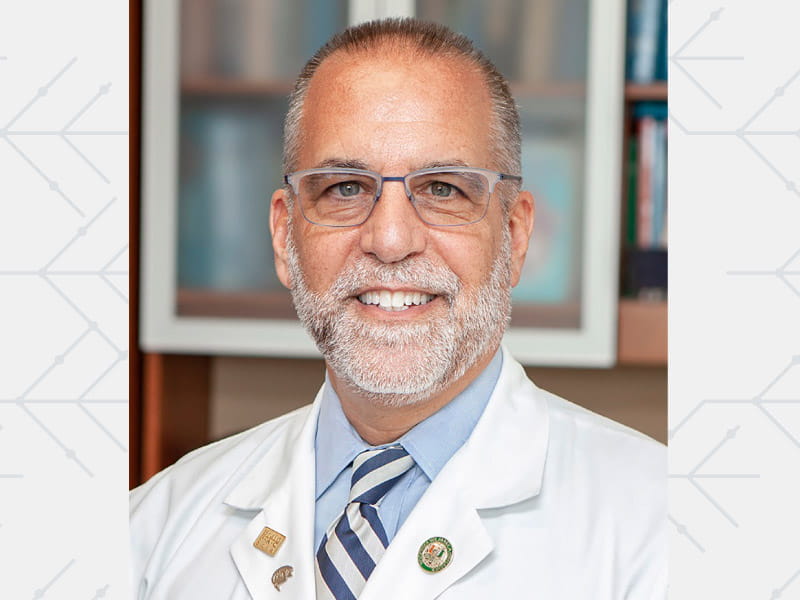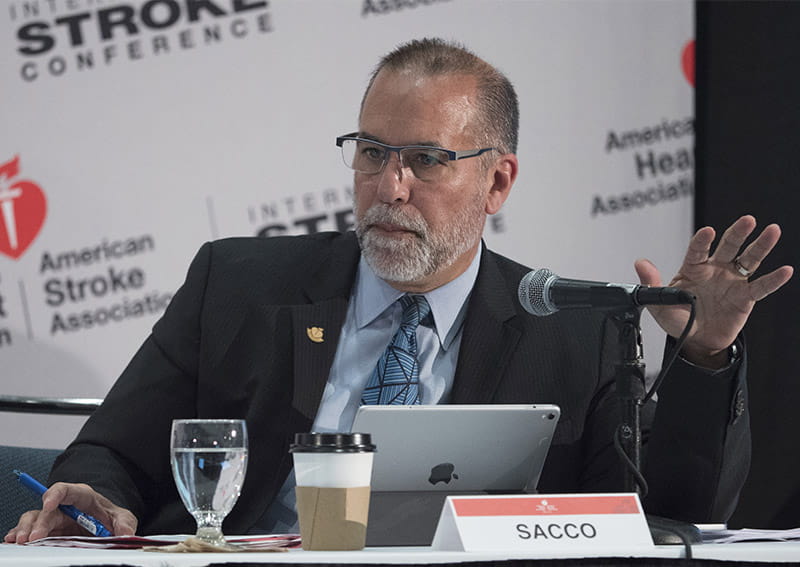Dr. Ralph Sacco – first neurologist to serve as AHA president – dies at 65
By Jaime Aron, American Heart Association News

Between his first and second years of medical school, before he was certain about what he'd specialize in, Ralph Sacco landed a job alongside Dr. Philip Wolf.
Sacco's role included feeding punch cards into a machine, a tedious but necessary step in the rudimentary days of electronic data collection. The fascinating part was seeing what happened next – the way Wolf used the information to save and improve lives, particularly those at risk of stroke.
Sacco veered his career down the same path, the combination of neurology and epidemiology. Like his mentor, he did so with great impact on large populations. Yet that was only part of the legacy Sacco forged. He took on major leadership roles, such as becoming the first neurologist to serve as president of the American Heart Association, then later became president of the American Academy of Neurology, both while leading many aspects of brain health at the University of Miami. Through it all, he regularly made time to mentor those who wanted to follow his path.
Sacco died Tuesday at his home in Amagansett, New York, with his family and loving husband, Scott Dutcher, by his side. Sacco had an aggressive brain tumor. He was 65.
American Heart Association CEO Nancy Brown remembered Sacco as a dear friend and an unparalleled leader whose "warm, generous heart and care transcended his research and clinic to every person fortunate to meet him."
"The Association is forever grateful that he chose to share his time and extraordinary talents with us," she said. "We will continue to honor his memory through the work we do to champion health equity and longer, healthier lives for all people."
Sacco's many roles at Miami included chairman of the department of neurology, executive director of the Evelyn F. McKnight Brain Institute and – in an example of his leadership more broadly in medicine – he was director of the university's Clinical and Translational Science Institute.
Sacco also was editor of the AHA's journal Stroke, the premier scientific journal for research in the stroke field. Overseeing the prestigious publication meant a lot to Sacco. Having long championed diversity and equity – particularly in his research – he declared that no more than half the editorial board would be white males. That was in 2020; by 2022, he'd achieved it.
"He saw that as part of his legacy – expanding the diversity of vascular neurologists and promoting the careers of the next generation of stroke leadership," said Dr. Mitchell Elkind, one of Sacco's proteges. "And he meant it. It's an example of why so many people in the stroke community adored him."
Elkind trained under Sacco at Columbia Presbyterian, then became co-director of the landmark research project that Sacco founded when Sacco went to Miami. He's since become the second neurologist to serve as AHA president and is now the organization's Chief Clinical Science Officer. These various vantage points gave Elkind a deep understanding of his mentor.
"He gravitated toward leadership positions because he knew he had something to contribute," Elkind said. "He succeeded because he had that combination of operational brilliance and intellectual capacity – all the things that make someone successful as an executive – as well as the warmth, compassion and humility of a physician."
Early days
Sacco was born in Margate City, New Jersey, the oldest of five kids in a family known for selling submarine sandwiches.
His grandfather was among several relatives who in 1947 opened White House Sub Shop, now an iconic spot in Atlantic City. In 1969, his father started another shop on the Jersey Shore. He gave it a name that cleverly fits both the business and the family: Sack O' Subs.
While many Saccos went from high school into the family business, Ralph went to Cornell University. His analytical, mathematical mind seemed well suited for electrical engineering. Then a few things happened.
An aunt who worked in a physician's office convinced him that those traits would work well in medicine. So he got a bachelor's degree in bioelectrical engineering, then went to Boston University School of Medicine.
His mother had mental illness, so Sacco was interested in "what makes us tick, what makes us who we are," he said in an October video chat with Elkind. Sacco said he also was interested in studying the brain because the grandfather who'd started the sub shop had a stroke. Although the patriarch survived – at a time when that was less common than today – this previously active, vibrant man became paralyzed and lost his love of life.
"I saw firsthand how much a stroke can affect the person who has it, as well as the whole family," Sacco told his hometown newspaper, The Press of Atlantic City, in 2010. The story also noted that Sacco kept a framed portrait of his grandfather in his office on the Miami campus.
In 1981, while at BU med school, Sacco received an American Heart Association Student Scholarship that essentially paid his salary while he worked for a scientist. That's how he joined Wolf's team.
Wolf was working on the Framingham Heart Study, a landmark longitudinal study in researching the risk of cardiovascular disease; to this day, it follows generations of people from Framingham, Massachusetts. When hired in 1967, Wolf was the first and only neurologist. He became the overall lead investigator in 1989.
Sacco continued working on Framingham data throughout his medical school career – "and did not require much supervision," Wolf said. Sacco was the lead author on two publications before he was even an intern, an unusual feat. (Sacco would go on to author more than 1,000 peer-reviewed articles.)
After med school, Sacco earned a master's degree in epidemiology from Columbia University. This is where Sacco added another mentor who was as much of a giant in his field as Wolf was in his: J.P. Mohr. The projects they worked on together included contributing to the creation of the national Stroke Data Bank.
Forging his own path
Mohr often told Sacco to "question everything, take nothing for granted." That attitude connects with Sacco wondering whether the lessons learned from studying the mostly white population in Framingham applied to people of other races and ethnicities. To find out, he launched the Northern Manhattan Study in 1991, studying the many populations of that diverse part of New York City. Like Framingham, NOMAS has both made profound impact and is still going strong. This is the project Sacco continued overseeing with a team in Miami while Elkind oversaw the team in New York.
Around the time NOMAS began, Sacco became more involved with the American Heart Association and its division, the American Stroke Association. He quickly realized he'd found an organization that shared his vision and approach toward improving the lives of all Americans.
Sacco held many key leadership roles with the AHA, including his presidency in 2010-11. His honors from the organization include the Distinguished National Leadership Award, the Gold Heart Award and the Distinguished Scientist Award.
"I was drawn to the organization because of the breadth of the people involved," Sacco said in the video chat with Elkind.

Many risk factors for heart diseases are also stroke risk factors. Sacco sought to emphasize that link, while delving deeper into those areas that would benefit both the heart and the brain. The success of his approach was best evidenced by his ascension to the presidency, the top spot for a science volunteer.
"It was sort of thinking ahead, evolving and expanding the mission, always looking forward to the next frontier," Sacco told Elkind.
His next frontier was becoming president of the American Academy of Neurology, from 2017-19. Sacco took great pride in strengthening the bond between the AHA and the AAN.
His final chapter
In 2021, Sacco caught COVID-19. Once recovered, he felt tingling in his leg. He thought it might be related to the virus. An MRI traced it to a tumor in his brain. Surgery removed it, but as a brain health expert, Sacco knew he probably had about 18 months to live.
"He became very organized about his estate planning, then he went back to work – he even wrote a grant application to fund future research after being diagnosed with a brain tumor," Elkind said. "People told him to stop working, travel the world. He said, 'This is who I am, this is what's important to me.'"
Away from medicine, Sacco proudly showed off his dance moves at weddings; took coastal vacations to Italy, the Caribbean, Chile and beyond; and especially enjoyed architecture. In addition to studying the work of great architects, he oversaw renovations of homes in Miami and the cottage in the Hamptons where he spent his final days.
Sacco's survivors include Dutcher, whom he married in 2014, as well as his father and all four siblings.
There's also what he called his "chosen family" of close friends, and his professional family – that is, a scientific family tree that traces backward through Mohr to C. Miller Fisher, who is considered the father of vascular neurology, and goes forward to a vast network forged over roughly 40 years mentorship.
Looking out for the next generation meant so much to Sacco that when asked by Elkind for a closing comment to their half-hour video chat, he said: "We have to send the message to our mentees to get involved with organizations.
"The organization gains and you gain," Sacco said. "And I think it's critical to advocate for the policies that will make a difference and to advocate for the funding that will make a difference for research for cardiovascular disease and stroke. All of us have to be part of the solution."
If you have questions or comments about this American Heart Association News story, please email [email protected].
Remembering Dr. Ralph Sacco
Read CEO Nancy Brown's tribute to Dr. Sacco





